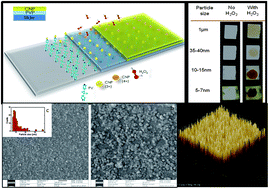Enzyme-free detection of hydrogen peroxide from cerium oxide nanoparticles immobilized on poly(4-vinylpyridine) self-assembled monolayers†
Abstract
A simple enzyme-free spectrophotometric detection of

* Corresponding authors
a University of Portland, Dept. of Chemistry, 5000 N. Willamette Blvd., Portland, OR 97203, USA
b EMSL, Pacific Northwest National Laboratory, Richland, WA 99352, USA
c
Battelle Science and Technology Pvt Ltd, 302 Panchshil Technology Park, Hinjewadi, Pune, India
E-mail:
Ajay.Karakoti@battelle-india.com
d Gumilyov Eurasian National University, Astana, Republic of Kazakhstan
e Nanoscience and Technology Center, Advanced Materials Processing Analysis Center, Materials Science and Engineering, University of Central Florida, Orlando, FL, USA
A simple enzyme-free spectrophotometric detection of

 Please wait while we load your content...
Something went wrong. Try again?
Please wait while we load your content...
Something went wrong. Try again?
J. D. Gaynor, A. S. Karakoti, T. Inerbaev, S. Sanghavi, P. Nachimuthu, V. Shutthanandan, S. Seal and S. Thevuthasan, J. Mater. Chem. B, 2013, 1, 3443 DOI: 10.1039/C3TB20204F
To request permission to reproduce material from this article, please go to the Copyright Clearance Center request page.
If you are an author contributing to an RSC publication, you do not need to request permission provided correct acknowledgement is given.
If you are the author of this article, you do not need to request permission to reproduce figures and diagrams provided correct acknowledgement is given. If you want to reproduce the whole article in a third-party publication (excluding your thesis/dissertation for which permission is not required) please go to the Copyright Clearance Center request page.
Read more about how to correctly acknowledge RSC content.
 Fetching data from CrossRef.
Fetching data from CrossRef.
This may take some time to load.
Loading related content
